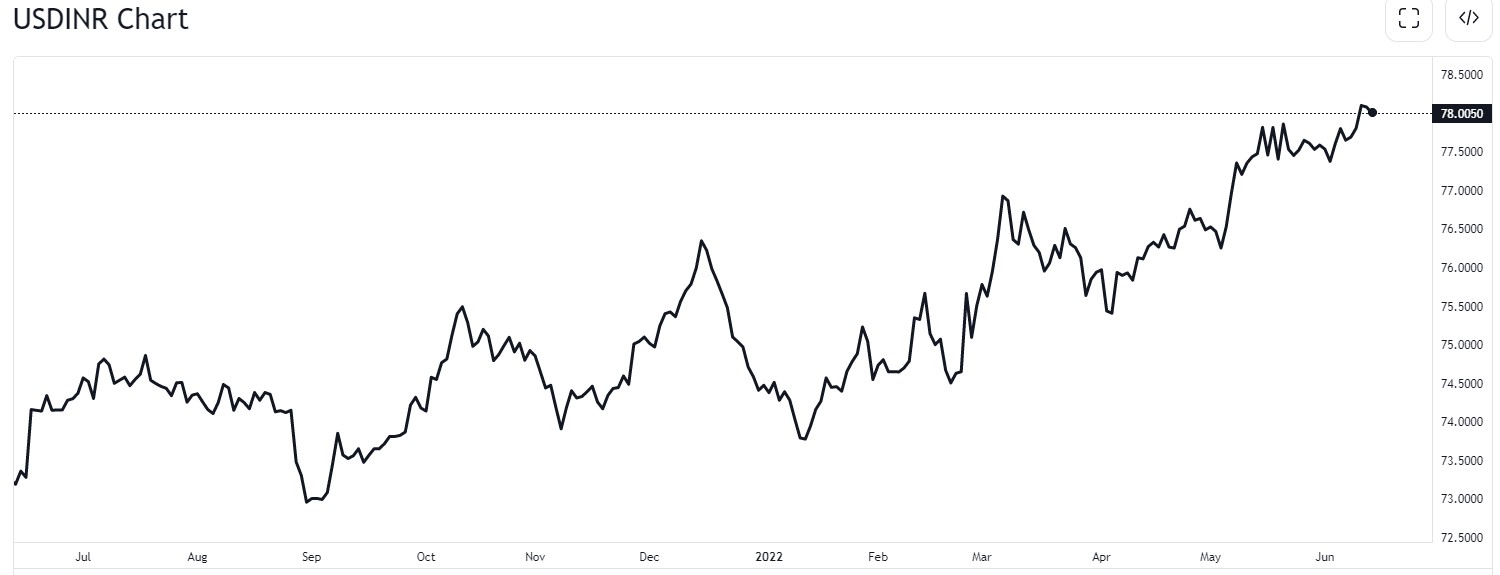Rupee weakens beyond Rs.78/$ - What is the story?

Last Updated: 11th December 2022 - 04:02 am
By now, you would even know it intuitively that the Indian rupee is under pressure. We started January 2022 with the rupee at about 74/$ and by June 2022 it has weakened by 5.2% to 78/$.
Of course, this is nothing close to the kind of rupee fall that we got to see in 2013, when more than 25% got wiped out in a span of few months. However, this remains a major concern considering the huge trade deficit that India runs. Check the chart.

Why is a weak rupee a concern for India? Firstly, India runs a trade deficit of over $20 billion per month or around $250 billion annually. The deficit will widen with weakening rupee. Secondly, India imports 85% of inputs like crude, coking coal etc.
A weaker rupee would mean higher level of imported inflation. Lastly, it takes away returns on investment. For instance, the Nifty may have fallen by 15% from the peaks, but for global investors if you add the currency impact, the dollar returns would be below -20%.So what is driving the rupee sharply lower?
Here are 5 factors driving the rupee weaker
1. Oil is on the boil
Crude oil was at around $70/bbl in the last quarter of 2021. Then came the Russia Ukraine war and the global supply chain of oil got disrupted. Russia is the world’s largest exporter and if Russia is cut off then it takes away about 10% of global supply.
That is going to be hard to replenish. In addition, there has been little investment in prospecting for fresh oil in the last few years and hence oil companies are unable to ramp output. The result is persistently high oil prices. With 85% of crude imported, the rupee is vulnerable.
2. FPIs have been in a hurry to exit India
Foreign investors have been bulls on the Indian market for a long time. But, what we have seen since October 2021, is almost something anomalous. More than $27 billion of FPI money has gone out since October 2021 with about $23 billion going out in 2022 itself.
This is more than the selling we have seen at any point of time. Even at the peak of the global financial crisis or the COVID pandemic, FPIs did sell so aggressively. While domestic flows have been strong, FPIs hit large caps and they also hit the rupee, so it is a double whammy.
Start Investing in 5 mins*
Get Benefits worth 5100* | Rs. 20 Flat Per Order | 0% Brokerage
3. Fed has a long hawkish road ahead
In the last 2 Fed meetings, the rates have been raised by a total of 75 bps to the range of 0.75%-1.00%. it is generally expected that considering inflation at 8.6% in May 2022, the Fed may hike rates by 75 bps instead of 50 bps in June. Either ways, the Fed targets rates to be at 3% to 3.2% by the end of 2022. That is very aggressive, but how does that impact the rupee? For that you need to look at the Bloomberg Dollar Index (DXY).
Since the start of 2022, the Dollar Index has spiked from 95 to 105, a level last seen 20 years back. Aggressive rate hikes means more flows into the dollar assets making the dollar strength. Obviously, that is making the rupee weak compared to the dollar. This is despite the fact that the US real yields are currently in the negative.
4. Uncertainty of imported inflation
That remains a big driver of a weak rupee. India imports more than 85% of its daily requirement of commodities like crude oil, coking coal etc. In the last one year, crude oil has doubled while coking coal is up 3-fold at $450/tonne.
For India, this is translating into a lot of imported inflation, widening the trade deficit and making the rupee weaker. To worsen matters, the war between Russia and Ukraine has also created supply chain constraints across the commodity supply chain and ensured that prices of goods and services are high.
5. Circa 2013: It was all about current account deficit
Back in 2013, the rupee run began with current account deficit spiking to 5% of GDP. Currently, it is nowhere close at under 2% of GDP. Also, the GDP base today is much larger. So, why is a higher current account deficit so dangerous? It is like borrowing for your morning breakfast.
It means that visible trade, invisible trade and remittances put together still leave a gap. In FY21, India had a current account surplus and that has fallen into a deficit. That has been putting a lot of pressure on the Indian Rupee.
Trending on 5paisa
05
 5paisa Research Team
5paisa Research Team
Discover more of what matters to you.
Disclaimer: Investment in securities market are subject to market risks, read all the related documents carefully before investing. For detailed disclaimer please Click here.

